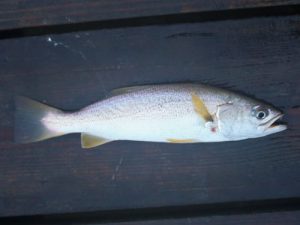
In Virginia, the gray trout is an iconic sport fish. This attractive member of the drum and croaker family is known as a hard fighter and fine fish for the table.
Overview
Gray trout (Cynoscion regalis) are found along the Atlantic coast of North America, most commonly from New York to North Carolina.
Gray trout also known by a variety of other names including weakfish, weakie, seatrout, yellowfin trout, and squeteague.
As water temperatures in the spring, adults begin to migrate inshore and north from their wintering grounds into the Chesapeake Bay, coastal bays, and nearshore coastal areas.
Gray trout reach sexual maturity within 2 years (90% by age 1, 100% by age 2).
Adults typically range from 12-18 inches in length. Rarely, 30 inches and 18 lbs. The largest gray trout ever recorded was caught in Delaware Bay and measured 30 inches in length and weighed 19 pounds, 2 ounces.
In the Chesapeake Bay region, gray trout have an average lifespan of 9 to 12 years.
Gray trout feed on crabs and fish; they can swallow fish up to 1/3 of their weight.
The name “weakfish”, refers to the thin, easily-torn membrane of the fish’s mouth.
The age of a gray trout can be determined by counting growth rings on their otoliths (ear bones).
2019 ASMFC Weakfish Assessment Update Highlights:
The 2019 Weakfish Assessment Update indicates weakfish continues to be depleted and has been since 2003.
In 2017, spawning stock biomass (SSB) was 4.24 million pounds. The assessment indicates some positive signs in the weakfish stock in the most recent years, with a slight increase in SSB and total abundance. Despite these gains, the stock is still well below the SSB threshold.
Given the weakfish management program is already highly restrictive with a one fish recreational creel limit, 100 pound commercial trip limit, and 100 pound commercial bycatch limit, the Board took no management action at this time.
The assessment indicates natural mortality (e.g., the rate at which fish die because of natural causes such as predation, disease, and starvation) has been increasing since the early 2000s. Fishing mortality was also high during the mid- to late 2000s.
Therefore, even though harvest have been at low levels in recent years, the weakfish population has been experiencing very high levels of total mortality (which includes fishing mortality and natural mortality), preventing the stock from recovering.
To better address the issues impacting the weakfish resource, the ASMFC Technical Committee recommends the use of total mortality (Z) benchmarks to prevent an increase in fishing pressure when natural mortality is high.
The assessment proposes a total mortality target of 1.03 and threshold of 1.43. Total mortality in 2017 was 1.45, which is above both the threshold and target, indicating that total mortality is too high. Fishing mortality has increased in recent years, but was below the threshold in 2017.
Weakfish commercial landings have dramatically declined since the early 1980s, dropping from over 19 million pounds landed in 1982 to roughly 180,560 pounds landed in 2017. The majority of landings occur in North Carolina and Virginia and, since the early 1990s, the primary gear used has been gillnets.
Discarding of weakfish by commercial fishermen is known to occur, especially in the northern trawl fishery, and the discard mortality is assumed to be 100%. Discards peaked in the 1990s but have since declined as the result of management measures and a decline in stock abundance.
Like the commercial fishery, recreational landings and live releases have declined over time. It is assumed that 10% of weakfish released alive die, so that total recreational removals are equal to the number of weakfish landed plus 10% of the weakfish released alive.
The assessment update used the new time-series of calibrated estimates of landings and live releases from the Marine Recreational Information Program.
Total recreational removals (coastwide) peaked in 1987 at 20.4 million pounds and have declined since then to slightly less than 500,000 pounds in 2017.
The proportion of fish released alive has increased over time; over the past 10 years, 88% of weakfish were released alive. Most of the recreational catch occurs in the Mid-Atlantic between North Carolina and New Jersey.
More information about ASMFC Weakfish Stock Assessments can be found at www.asmfc.org, on the Weakfish page.
Related Information